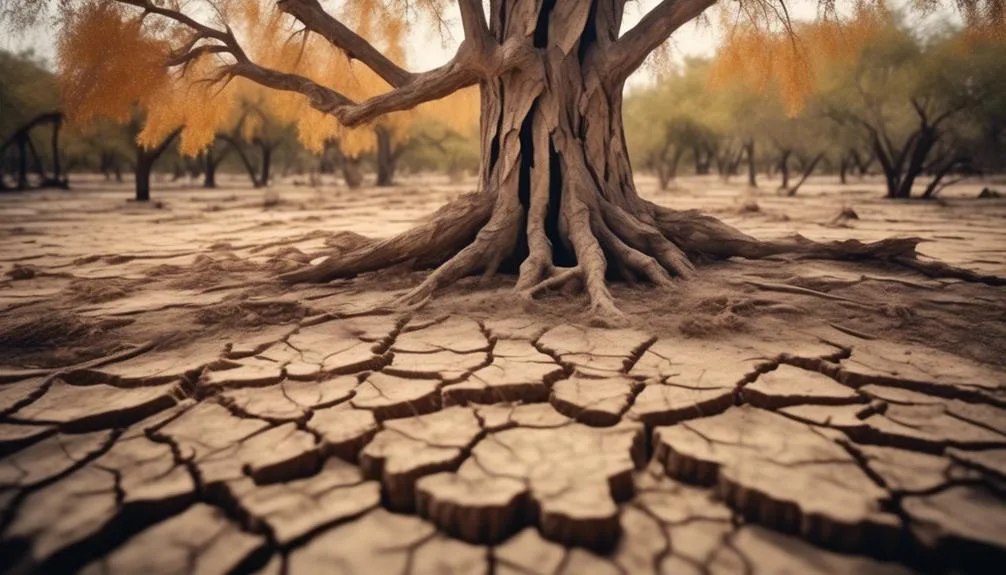Can Hickory Trees Survive Drought
Picture a dense forest filled with the scent of hickory trees. Can these tall and sturdy trees endure drought?
Explore the systems and adaptations that help hickory trees face environmental challenges. What strategies do these giants use to survive drought?
Drought Tolerance of Hickory Trees
If you're curious about how hickory trees manage to thrive in dry conditions, their remarkable drought tolerance is a testament to their adaptability and resilience in the face of water scarcity.
This remarkable ability is partly due to their genetic diversity, which enables them to adapt to varying environmental conditions, including limited soil moisture. Hickory trees possess a range of genetic traits that allow them to efficiently use available water, whether it's through deep root systems that can tap into groundwater or specialized leaf structures that minimize water loss through transpiration.
Their genetic diversity also means that different hickory species and individual trees within those species may have varying degrees of drought tolerance, ensuring that some will be better equipped to survive in drier conditions than others.
This adaptability and genetic diversity make hickory trees fascinating and resilient in the face of drought.
Adaptive Features of Hickory Trees
With their deep root systems and specialized leaf structures, hickory trees exhibit remarkable adaptive features that enable them to thrive in diverse environmental conditions, including periods of drought. These adaptive features play a crucial role in the survival of hickory trees amidst climate change and varying soil compositions.
The deep taproots of hickory trees allow them to access water sources from deep within the ground, providing resilience during periods of drought. Additionally, their specialized compound leaves minimize water loss through transpiration, helping the trees retain moisture and survive in arid conditions.
These adaptive features not only enhance the hickory trees' ability to withstand drought but also contribute to their overall resilience in the face of changing environmental conditions. As climate change continues to impact ecosystems, the adaptive nature of hickory trees positions them as vital components of sustainable forest ecosystems.
Strategies for Hickory Trees During Drought
What strategies do hickory trees employ to survive and thrive during periods of drought?
Hickory trees have developed remarkable strategies to withstand drought conditions. One essential strategy is water conservation. During dry periods, hickory trees reduce water loss by closing the stomata, tiny openings on their leaves, to minimize transpiration.
Additionally, hickory trees have deep and extensive root systems that enable them to access water deep within the soil, even during droughts. These root systems can extend far beyond the tree's canopy, allowing the tree to tap into water sources that other plants can't reach.
Impact of Drought on Hickory Trees
Even during infrequent droughts, hickory trees exhibit remarkable resilience and adaptability in the face of challenging environmental conditions. These trees have evolved strategies to cope with water scarcity, ensuring their survival even in arid climates. The impact of drought on hickory trees is mitigated by their impressive water conservation mechanisms and specialized root system adaptations.
| Impact of Drought on Hickory Trees | |
|---|---|
| Water Conservation | Hickory trees reduce water loss through leaf curling and shedding. This helps them conserve moisture during drought. |
| Root System Adaptations | The deep taproots of hickory trees enable them to access water from deeper soil layers, allowing for sustained growth during drought periods. Additionally, their extensive lateral roots efficiently capture moisture from a larger soil area. |
These remarkable adaptations enable hickory trees to withstand drought conditions and continue thriving even in challenging environments.
Ensuring Hickory Tree Survival During Drought
To ensure the survival of hickory trees during drought, they rely on their remarkable water conservation mechanisms and specialized root system adaptations.
To help them through dry spells, you can also implement the following techniques:
- Irrigation Methods: Consider using drip irrigation or soaker hoses to deliver water directly to the roots of hickory trees. This method can help ensure that the trees receive water efficiently without wastage.
- Mulching Techniques: Apply a layer of organic mulch around the base of the trees to conserve soil moisture and regulate soil temperature. This helps to reduce water evaporation and maintain a more consistent moisture level in the root zone.
- Watering Schedule: Establish a consistent watering schedule, especially during prolonged dry periods, to supplement natural rainfall and support the trees' water needs.
Conclusion
In adapting to dry conditions with deep roots, thick bark, and efficient water use, hickory trees demonstrate remarkable resilience against drought. Monitoring and managing their well-being amidst changing environmental conditions remains crucial.
How might their survival strategies inspire our approach to tackling challenges in an ever-changing world?
Mark Hoffman is a dedicated arborist and tree care specialist with over a decade of experience. His love for trees began when he visited Yosemite National Park as a teenager and was awestruck by the giant sequoias. Mark pursued his passion by studying forestry at Michigan Technological University, where he earned a Bachelor of Science degree.
Since then, he has worked tirelessly in the field of arboriculture, helping to preserve and protect trees in his community. His expertise and dedication have made him a respected leader in the industry and a valuable resource for anyone seeking advice on tree care.
